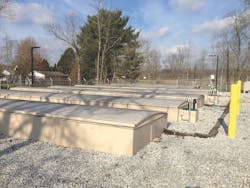Effluent Sewer Addresses Odor & Aging Infrastructure
Patrick Foley is a systems engineer for Orenco Systems Inc. Foley can be reached at [email protected]. Mike Saunders is market segment leader of engineered systems for Orenco Systems Inc. Saunders can be reached
at [email protected].
About 90 miles east of Columbus, Ohio, lies the village of Lore City, incorporated in 1906. Sewage collection and treatment in the village was historically handled by onsite septic tanks and drain fields. Unfortunately, as those systems aged and began to fail, the village was increasingly plagued with unpleasant odors.
In 2011, the village council hired URS Corp., an engineering and construction firm, to provide the municipality with a sewer solution for its community of a little more than 300 people. The village had secured a loan from the Ohio Water Development Authority (OWDA) for the design work. Because loan payments were scheduled to begin shortly after the funding was distributed, residents began paying a monthly sewer bill during the design phase of the sewer.
In 2012, URS presented its design for a gravity sewer followed by a package treatment plant. Unfortunately, the engineer had underestimated the construction costs, and during the first round of project bidding, no bids were received because the engineer’s cost estimate was too low.
Not Once, but Twice
URS reintroduced the project with a higher engineer’s estimate and received two bids that both exceeded the estimate by more than $200,000. Additionally, while the bids received were both higher than the engineering estimate, the estimate was also higher than the amount of funding available. The ramifications were not good for anyone involved. Residents had been paying a monthly sewer bill for nearly two years and yet the project was now at a complete standstill. The community was left with no sewer infrastructure and a monthly loan payment to OWDA for design work that had gotten the village nowhere.
After the second attempt to bid the project failed, the URS project manager passed the information on to personnel at OWDA and the Ohio EPA because both agencies had committed to funding the project. These personnel were familiar with Orenco’s work in other parts of the state and recommended that URS contact Orenco for possible solutions.
Effluent Sewer Savings
Orenco offered a sewer solution that would meet the city’s budget, which was an effluent sewer for wastewater collection followed by an AdvanTex AX-MaxTM wastewater treatment facility. Because of the first two failed proposals, the URS engineer was hesitant to make a third, but research revealed the septic tank effluent pump (STEP) collection system used in this sewer would provide a significant cost savings over the gravity sewer specified in the first two proposals.
These effluent sewers can be installed with less-intrusive construction methods than gravity sewers, which reduces a number of byproducts of the construction process, including adverse environmental impacts, permitting concerns, problems with handling and disposing of excavated soils and groundwater, the number and cost of utility conflicts and resulting relocations, and the high cost of surface restoration.
Also, effluent sewers experience minimal infiltration and inflow throughout the collection system because service laterals and mainlines are pressurized, mains are shallowly buried, and manholes are not needed.
As the project engineer continued her research she also found that local rules requiring separation between the treatment plant and residences were such that a low-odor AdvanTex facility could be located in the village itself, while an extended aeration package plant would have to be farther away. By locating the treatment facility closer to the homes it would serve, the village could save even more money.
In this effluent system, the onsite primary tank at each residence captures and digests more than two-thirds of gross solids, grease and oils, which produces effluent that is primary-clarified, treated and fine-screened before it ends up at the treatment facility. A smaller load to the facility means size and cost can also be reduced. In addition, this treatment facility offered low energy consumption and low maintenance requirements, as well as its ability to successfully treat highly variable flows.
To confirm the Orenco solution was the best option, the engineer, the mayor of Lore City, and members of the village council visited Christiansburg, Ohio, which has benefited from its own Orenco Sewer and AdvanTex treatment since 2014. After seeing the success at Christiansburg—another small village with limited resources—the Lore City council members were convinced the Orenco plan would finally allow them to obtain the sewer system they would need for years to come.
The Third Time Is the Charm
By 2017, the village had secured a new funding package through the U.S. Army Corps of Engineers and the Ohio EPA. When the project was opened for bidding, two bids were received and all parties were relieved that both bids were lower than the engineering estimate.
Construction on the treatment facility began in the spring and seven AdvanTex AX-Max units were installed in the fall. These systems use a fixed-film, attached-growth treatment process, which is an effective solution for small communities and small-flow applications. In an AdvanTex system, wastewater is uniformly distributed onto textile media in an unsaturated condition. The system uses low-horsepower fans to draw air through the media and provide sufficient oxygen for aerobic digestion. These low-horsepower, high-head turbine pumps operate intermittently with sophisticated controls that automatically adjust recirculation ratios and pump run-times based on daily flows.
In 2013, during the second unsuccessful attempt to bid the Lore City sewer project, the lowest bid received had been more than $4.8 million. But in 2017, the low bid had dropped to less than $3.7 million. Replacing a proposal for gravity sewer and a package treatment plant with the Orenco Sewer followed by AdvanTex treatment made a difference for the people of Lore City.
